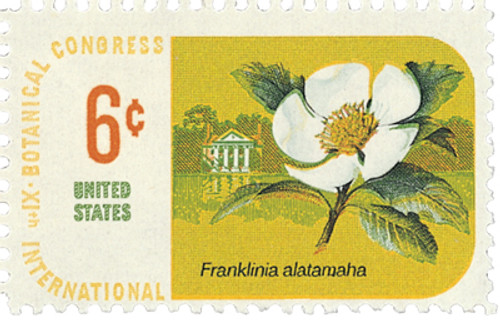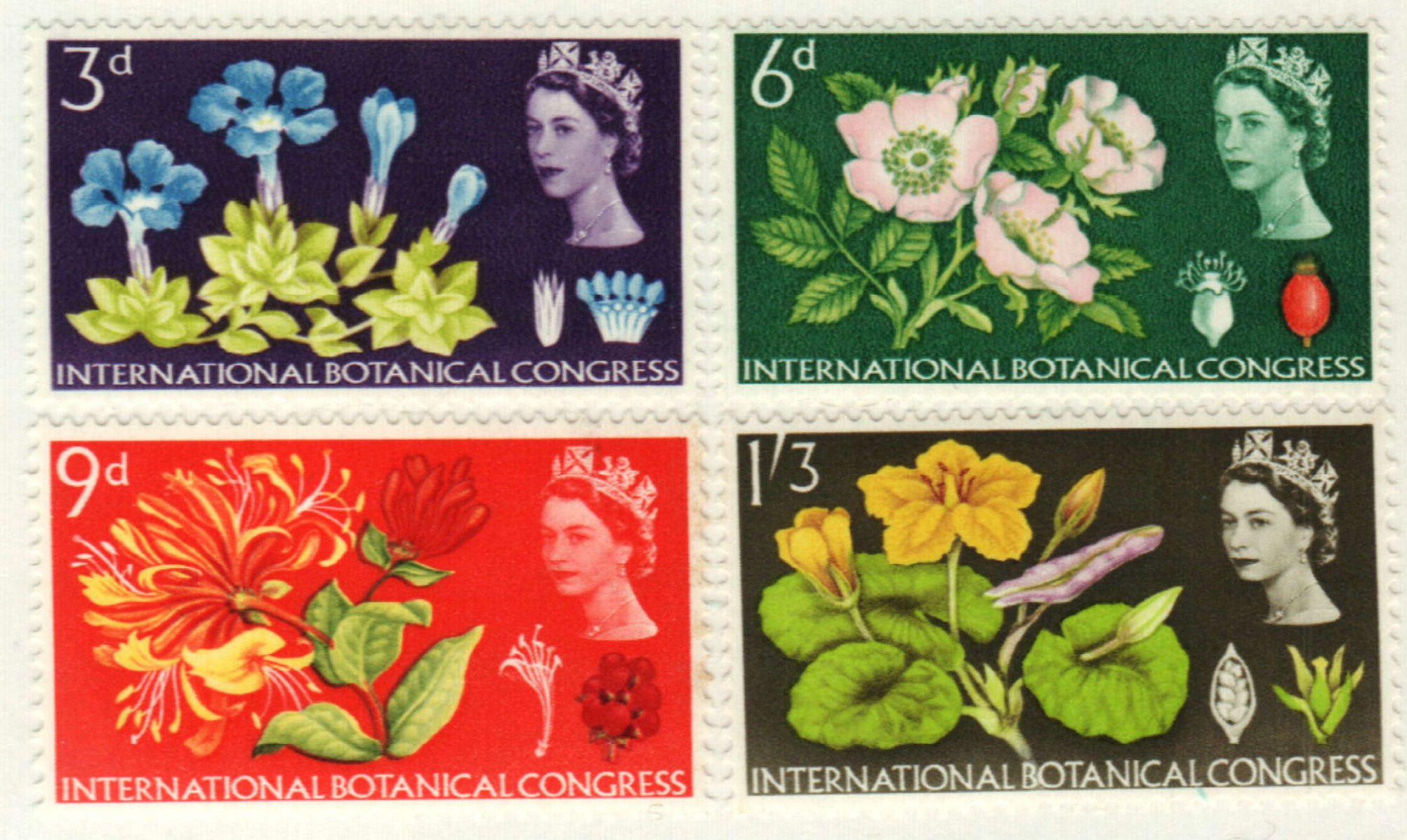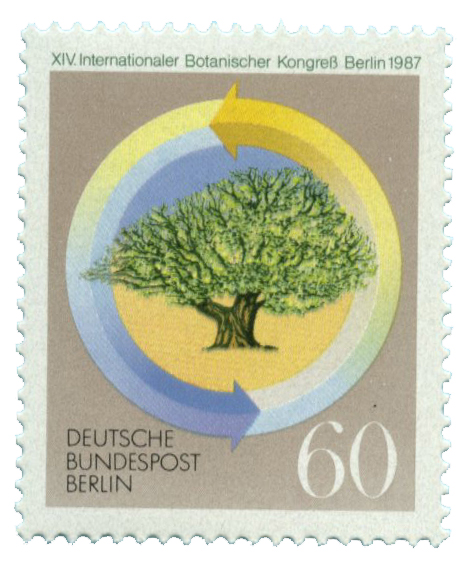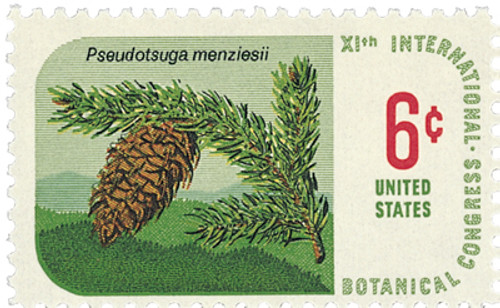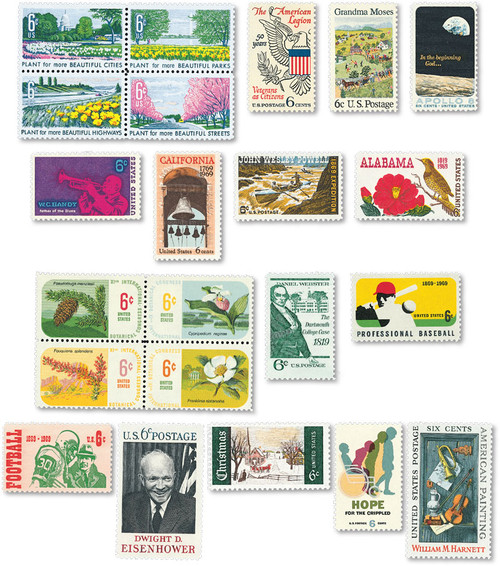
# 1379 - 1969 6c Botanical Congress Franklin Tree
Issue Date: August 23, 1969
City: Seattle, WA
Quantity: 159,195,000
Printed By: Bureau of Engraving and Printing
Printing Method: Lithographed, engraved
Perforations: 11
Color: Multicolored
11th International Botanical Congress
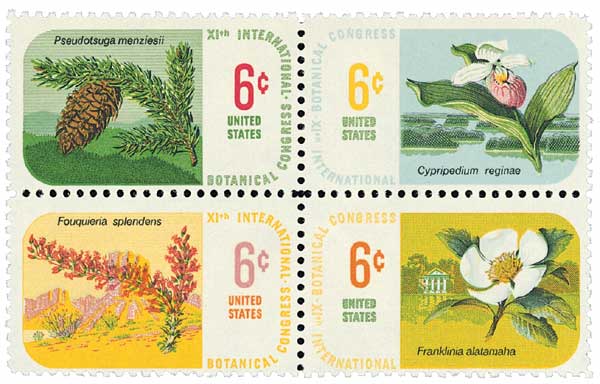
On August 23, 1969, the US Post Office issued a set of four stamps for the 11th International Botanical Congress (IBC).
They were the first US stamps that honored flora from each of the four corners of the United States. They were also the first to include Latin names.
Prior to the creation of the IBC, local botanical groups held meetings in their own areas to discuss the natural sciences. Over time, these groups grew large and many called for a large international organization.
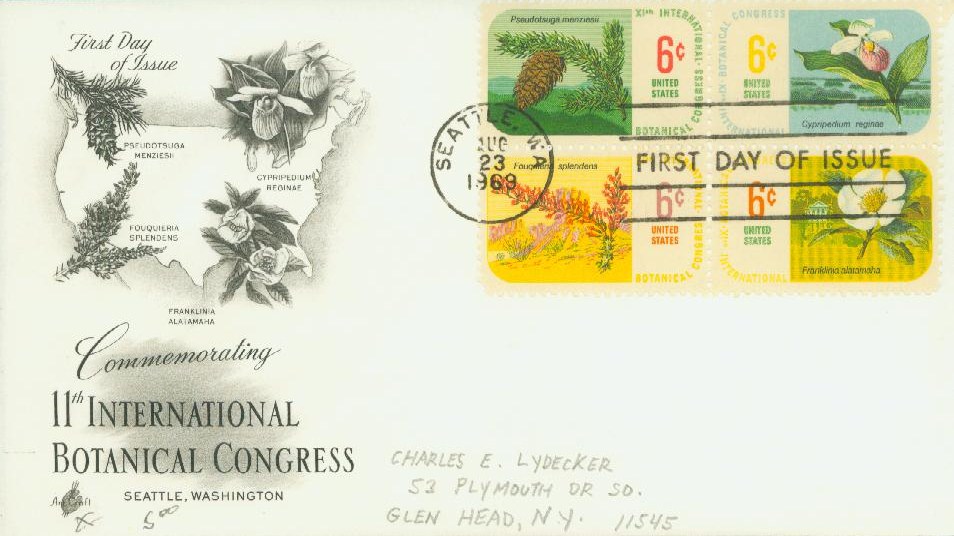
The first meeting of the IBC was held in 1864, in Brussels, Belgium. The meeting’s time and place were selected to coincide with an international horticultural exhibit there. The conference was held annually for several years. At many of these meetings, several members requested that they standardize botanical nomenclature (scientific naming of the plants). While there was some discussion on the topic, the official rules weren’t set for several years.
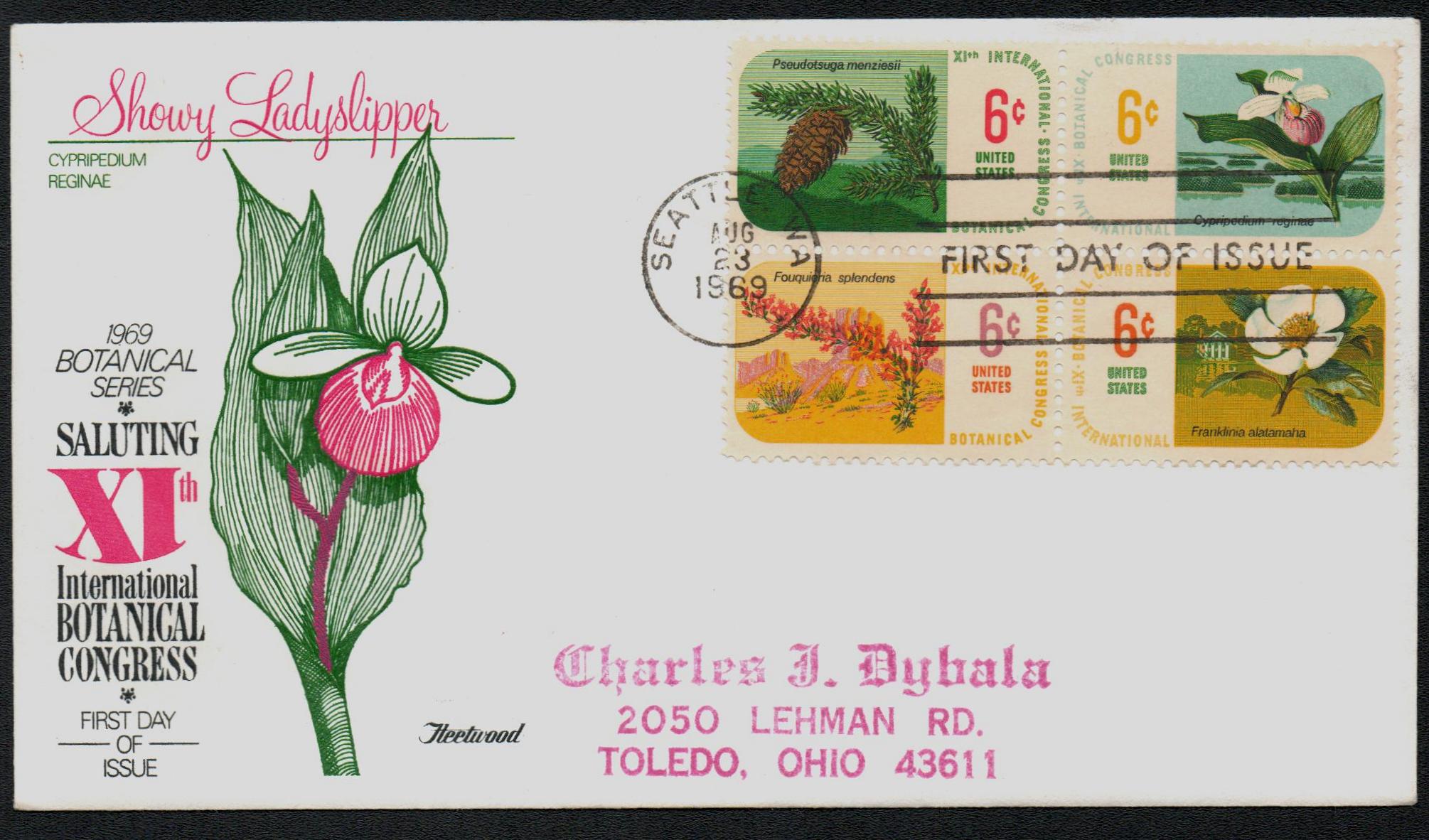
Although the congresses date back to 1864, the formal numbering system still in use today wasn’t implemented until 1900. So the 1900 Congress is generally referred to as the First International Botanical Congress. Since then, the meetings have generally been held about every five or six years. During these early congresses, they adopted French as the official language of their meetings, then changed it to English in 1935, and established that Latin would be used for plant descriptions.
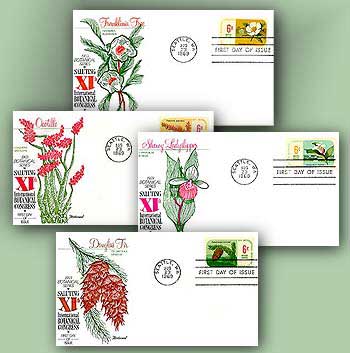
Up until 1926, all of the meetings had been held in Europe. The first one outside of Europe was held that year in Ithaca, New York. The IBC returned to the US in 1969 for the 11th Congress in Seattle, Washington. At that meeting, they established the International Association of Bryologists (bryology is the study of mosses, liverworts, and hornworts). For the next several decades the meetings rotated between Europe, North America, and Australia. The first meeting in Asia occurred in 1993 in Japan.
The most recent meeting was held in 2017 in China. You can learn about it here.
About the stamps…
The flora pictured on the IBC stamps are the ocotillo from the Southwest, the Douglas fir native to the Northwest, the Northeast’s lady’s slipper, and the Southeastern franklinia.
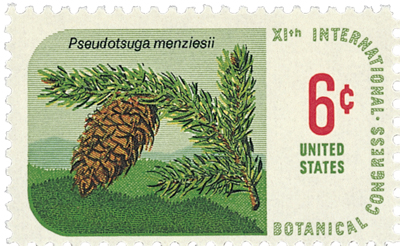
Named after Scottish botanist David Douglas, the douglas fir is not a true fir. It grows along the West coast from British Columbia to central California. The douglas fir can be found from the Cascade and Sierra Nevada mountains to the Pacific shoreline. It can survive at elevations from sea level to 5,900 feet. This tree is the second-tallest conifer in the world and can grow to 250 feet or more. This species lives more than 500 years and has been known to survive over 1,000 years.
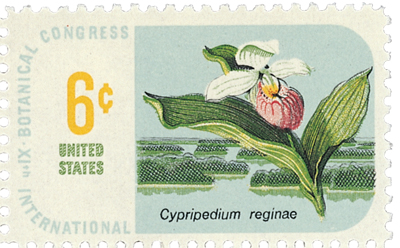
Another stamp in the block pictures the lady’s slipper. A member of the orchid family, this perennial flower grows from six to fifteen inches tall. It can live for over twenty years. In the past, its roots were used to treat nervousness, toothaches, and muscle spasms. The lady’s slipper must grow near a certain fungus found in the soil. Because the flower’s seeds don’t have an ample supply of nutrients, they rely on threads from the fungus for nourishment. When the lady’s slipper has matured enough to produce its own food supply, the fungus then shares some of those nutrients.
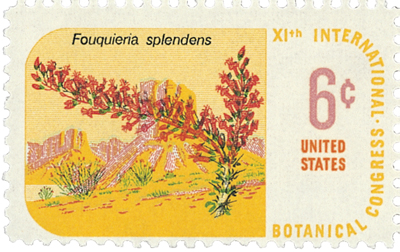
The ocotillo is also called candlewood, desert coral, or vine cactus. It grows in the Sonoran and Chihuahuan Deserts of Southwestern US and Northern Mexico. The ocotillo can grow to 33 feet tall. In drier weather, the plant appears dead, but when it rains small leaves and bright crimson flowers appear. Hummingbirds and carpenter bees pollinate the flowers.
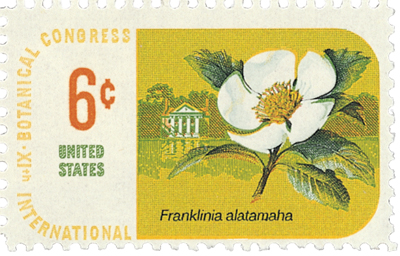
The fourth stamp pictures the franklinia. Named for Benjamin Franklin, this tree was discovered by botanists John and William Bartram, who are honored on US #3314. The plant was only found in a three-acre spot along Georgia’s Altamaha River. It became extinct in the wild in the early 1800s. The cultivated specimens in existence today are all descended from seeds collected by the Bartrams.
Several nations have issued stamps when they hosted the IBC. See a couple below:
Issue Date: August 23, 1969
City: Seattle, WA
Quantity: 159,195,000
Printed By: Bureau of Engraving and Printing
Printing Method: Lithographed, engraved
Perforations: 11
Color: Multicolored
11th International Botanical Congress

On August 23, 1969, the US Post Office issued a set of four stamps for the 11th International Botanical Congress (IBC).
They were the first US stamps that honored flora from each of the four corners of the United States. They were also the first to include Latin names.
Prior to the creation of the IBC, local botanical groups held meetings in their own areas to discuss the natural sciences. Over time, these groups grew large and many called for a large international organization.

The first meeting of the IBC was held in 1864, in Brussels, Belgium. The meeting’s time and place were selected to coincide with an international horticultural exhibit there. The conference was held annually for several years. At many of these meetings, several members requested that they standardize botanical nomenclature (scientific naming of the plants). While there was some discussion on the topic, the official rules weren’t set for several years.

Although the congresses date back to 1864, the formal numbering system still in use today wasn’t implemented until 1900. So the 1900 Congress is generally referred to as the First International Botanical Congress. Since then, the meetings have generally been held about every five or six years. During these early congresses, they adopted French as the official language of their meetings, then changed it to English in 1935, and established that Latin would be used for plant descriptions.

Up until 1926, all of the meetings had been held in Europe. The first one outside of Europe was held that year in Ithaca, New York. The IBC returned to the US in 1969 for the 11th Congress in Seattle, Washington. At that meeting, they established the International Association of Bryologists (bryology is the study of mosses, liverworts, and hornworts). For the next several decades the meetings rotated between Europe, North America, and Australia. The first meeting in Asia occurred in 1993 in Japan.
The most recent meeting was held in 2017 in China. You can learn about it here.
About the stamps…
The flora pictured on the IBC stamps are the ocotillo from the Southwest, the Douglas fir native to the Northwest, the Northeast’s lady’s slipper, and the Southeastern franklinia.

Named after Scottish botanist David Douglas, the douglas fir is not a true fir. It grows along the West coast from British Columbia to central California. The douglas fir can be found from the Cascade and Sierra Nevada mountains to the Pacific shoreline. It can survive at elevations from sea level to 5,900 feet. This tree is the second-tallest conifer in the world and can grow to 250 feet or more. This species lives more than 500 years and has been known to survive over 1,000 years.

Another stamp in the block pictures the lady’s slipper. A member of the orchid family, this perennial flower grows from six to fifteen inches tall. It can live for over twenty years. In the past, its roots were used to treat nervousness, toothaches, and muscle spasms. The lady’s slipper must grow near a certain fungus found in the soil. Because the flower’s seeds don’t have an ample supply of nutrients, they rely on threads from the fungus for nourishment. When the lady’s slipper has matured enough to produce its own food supply, the fungus then shares some of those nutrients.

The ocotillo is also called candlewood, desert coral, or vine cactus. It grows in the Sonoran and Chihuahuan Deserts of Southwestern US and Northern Mexico. The ocotillo can grow to 33 feet tall. In drier weather, the plant appears dead, but when it rains small leaves and bright crimson flowers appear. Hummingbirds and carpenter bees pollinate the flowers.

The fourth stamp pictures the franklinia. Named for Benjamin Franklin, this tree was discovered by botanists John and William Bartram, who are honored on US #3314. The plant was only found in a three-acre spot along Georgia’s Altamaha River. It became extinct in the wild in the early 1800s. The cultivated specimens in existence today are all descended from seeds collected by the Bartrams.
Several nations have issued stamps when they hosted the IBC. See a couple below:

